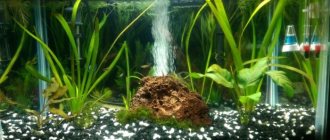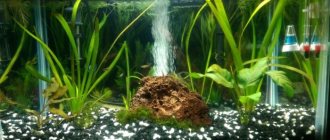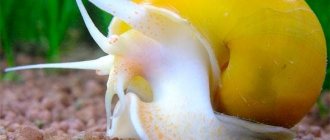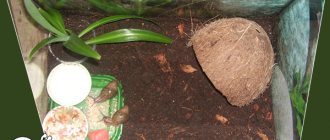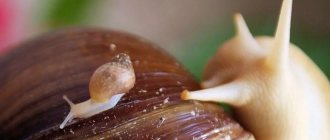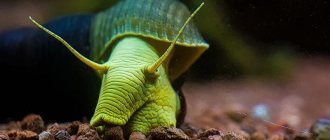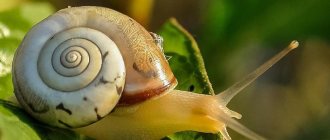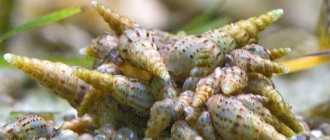Ready-made houses for your beloved pets can be purchased in special stores or ordered online. The package includes instruments - a hygrometer and a thermometer, and the walls and lids are made of durable, safe materials. Ventilation in the terrarium is provided by a well-thought-out system. However, not every novice breeder will be able to purchase such a luxurious shellfish house.
However, old aquariums and plastic containers can provide an alternative to expensive molluscs. In these homemade houses, the owners themselves create favorable conditions for small defenseless pets.
Why ventilation in a terrarium?
Previously, African snails were kept in aquariums without ventilation.
It was believed that mollusks did not need oxygen in large quantities. However, in such conditions the air stagnated, humidity increased, and condensation formed on the walls. This had a beneficial effect on the development of mold, mildew and various parasites. Due to the increased humidity and stuffiness, many snails became stressed, retreated and died.
Then keepers began using ventilated lids. But this didn't solve the problem. Only the top of the terrarium was ventilated, and the air above the ground remained heavy, and the ground also turned sour.
Reproduction
Reproduction of ampullaria snails in an aquarium is an interesting process. If optimal conditions are created, adults will regularly lay eggs in clusters on the walls of the aquarium in the space between the lid and the surface of the water.
To ensure the viability of future offspring, it is necessary:
- lightly moisten the masonry and carefully separate it from the wall of the aquarium;
- transfer the eggs to a separate tank and place them on a floating object;
- Regularly lightly moisten the eggs to prevent them from drying out.
If you leave the eggs in the main aquarium, then, after hatching after three to four weeks, the babies will fall to the bottom, where they will most likely be eaten by fish. Therefore, small snails must be kept separately.
To reproduce ampullaria snails in an aquarium, it is necessary to provide them with a sufficient amount of food and leave a free space above the surface of the water with a height of about 12 cm.
Proper ventilation for snails
On the Internet you can see photos of containers with ventilation on the lid. This is wrong and at the same time, no. People are so used to it. They open the container for ventilation, fluff up the soil, and remove leftover food every day to prevent it from rotting. Why make life so difficult? There is an easier way to provide the snail with fresh air and humidity.
How to do it?
Ventilation holes are made above the ground (10 mm from the surface) along the entire length of the terrarium wall. The optimal diameter of the holes is 2 mm, a thin drill, an awl or a nail can easily cope with this task. The distance between the holes is 2-3 cm. It is worth saying that the ventilation holes can be in one or two rows, it all depends on the height of the terrarium. To improve traction, additional holes are made in the opposite wall below the cover.
Sometimes snail breeders make the mistake of making 5 large holes instead of 25 small ones. Through large holes, midges easily penetrate the container and lay eggs. A few days later there are hordes of midges in the room, which are terribly annoying.
Types of houses for Achatina
Several options may be suitable as an utilitarian:
- Aquarium for fish. It is good because it uses environmentally friendly material – glass. In addition, it is not difficult to buy it - it is sold in any pet market. However, ventilation problems may arise.
- Terrarium. This option will also most likely require solving the ventilation issue. Disadvantages include high cost, high weight and reduced impact resistance. But glass is chemically neutral and more transparent than plastic.
- Plastic container. In this case, there will be no problems with ventilation. To make a terrarium for snails ventilated, it is enough to drill two small holes from 5 to 6 mm on two opposite sides. Holes are drilled on one wall 3-4 cm from the top edge, on the other - 3-4 cm from the base.
You need to take a close look at the quality of the plastic itself.
It is important that it is labeled “food grade”. The obvious advantage of plastic containers for Achatina snails is their budget cost
You can buy it even with a limited supply of funds. In addition, there is always a wide selection of shapes and sizes, impact resistance, ease of operation, and low weight. Another plus is that plastic heats up slowly and has poor thermal conductivity, so your pet will avoid sudden temperature changes.
Another option is a homemade ulitharium. But to make it practical and convenient, you will need to know the principles described above. At the same time, houses made of plywood and cardboard are definitely not suitable.
It can also be noted here that Achatina is a mollusk with a terrestrial lifestyle. This means that the best option would be a horizontal terrarium for snails.
Why can't you use gauze as a lid?
If the terrarium is not covered with a lid, all the moisture from it will evaporate. You will have to constantly moisten the soil and the walls of the container. However, the air will remain dry and the soil will become wet. This difference is bad for the health of snails.
The same can be said about aquariums with poorly fitting lids. Of course, the moisture will not disappear as quickly as through gauze. However, you can choose the frequency of irrigation and its abundance, but this must be done under the control of a hygrometer.
How do ampullaria reproduce?
Popular Amazonian snails with a yellow or brown-yellow shell reach a diameter of 10 cm. Ampularia is a heterosexual species.
It is impossible to determine the gender; the female does not differ from the male in appearance. Therefore, aquarists buy 4-6 individuals for breeding. You can understand which gender is which by seeing how ampullaria reproduce in an aquarium: the male is always on top during the mating process.
Sexual maturity occurs at 1.5 years. How do yellow snails reproduce in an aquarium:
- After fertilization, eggs are formed in the female's body.
- She deposits them above the water in the form of a slimy mass that hardens in the air.
- In nature, masonry rests on coastal stones and plants. In ampullaria, reproduction in an aquarium occurs on a glass aquarium wall.
- At first, the eggs are translucent, white, with a soft shell, and are 2 mm in diameter. They gradually darken - shells form inside. Just before the young hatch, the eggs are dark brown and hard.
- The developed snails gnaw through the shell of the eggs and come out.
It is necessary to monitor how the snails lay eggs in the aquarium: the clutch should not be allowed to get into the water or get wet, otherwise the embryos will die
How to care for ampularia eggs: drying out of the masonry is unacceptable; if it is laid near a lighting fixture, it will have to be carefully cut off and moved to another place inaccessible to fish and predatory snails. To make it easier to care for caviar, you can place it on a piece of foam plastic placed on the surface of the water.
How quickly snail eggs mature in an aquarium depends on the temperature of the surrounding water. At a temperature of 24-26°C, the ripening period is 2 weeks. At 20°C, young animals appear after 3 weeks.
Caring for young animals is simple: feed – duckweed, finely chopped lettuce leaves, dry planktonic crustaceans. When bred in a community aquarium, young specimens can be eaten by fish, so it is better to move them to a separate tank.
How to make ventilation for snails in a container
Holes are made with a hot awl, nail or soldering iron. The diameter should not exceed 3 mm. Ventilation holes are made above the ground along the entire length of the wall. The same thing is done on the other side, only under the lid. People sometimes ask me how many holes should be made? There is no exact answer. The holes should be every 3 cm, so count for yourself how many are needed.
Before making holes, you need to consider whether there will be heating in the container or not. In a heated container, the holes are located above the ground and under the lid on opposite wide walls. In a container without heating, the holes are located above the ground at the same level, on both sides.
Watch a video about ventilation in a terrarium for Achatina snails
Source
Where to get a silicone snail bowl
If you also want to switch to silicone bowls, just go to any kitchenware store. A store for people, not animals. And buy silicone muffin tins.
When my snail was very small, I had two small molds, which I cut so that they were no more than 1.5 cm in height. So that the snail would not drown or suffocate in food or water.
Large bowls
As she grew older, I bought larger molds. Since then I have only used them and am very happy. Snail, I think too)))
The asking price is 20-100 rubles per bowl. And one hundred percent safety.
A note to caring owners - what kind of ventilation should be in the terrarium?
Novice breeders mistakenly believe that the holes in the lid completely ensure the flow of oxygen. However, owners should be aware that without cyclic ventilation, air stagnation occurs in the terrarium and dangerous mold and fungi form.
Good ventilation in the terrarium is ensured by small holes in the walls of the house. The flow of fresh air should ventilate the soil well, and the humidity in the terrarium should be at least 75%-85%.
To achieve this effect, holes are punched in the walls close to the surface of the soil with a drill or a heated awl. The ideal diameter of the holes is up to 3 mm, and the distance between them is 2.5-3 cm. A ready-made colander will provide a slight draft and help moisture evaporate from the soil.
The following holes are made in the upper part of the wall of the molluscarium. Circular ventilation
an aquarium is suitable for a house if a heating lamp is installed in it. The light source heats the air, which penetrates through the lower holes and then exits through the upper ones located under the lid.
Important! The lid of the molluscarium should tightly close and isolate the house from the outside world. This is double protection, residents will not be able to run away and break their sink, and friends who come to visit will not harm defenseless pets.
How to care for them?
1. Ulitkarium.
A snail terrarium or terrarium for a snail can be either a fish aquarium or a plastic terrarium. A necessary condition is a lid with holes to allow fresh air to enter. The size of the holes should be smaller than the snail itself. The average Achatina snail needs an aquarium with a volume of 3 liters for a comfortable stay.
2. Filler.
The filler for the container can be coconut substrate, sand, or nut shells. It should be taken into account that snails love to burrow into the ground, especially during the day. The minimum height of the soil should be 4 cm. It is important that the soil is always moist so that the snails can move comfortably. If the soil is dry, Achatina will wet it with its mucus, which will lead to contamination of the walls of the container.
3. Food.
The older the snail, the less often you can feed it. These animals feed mainly on greens, apples, bananas, and cucumbers. It is important that the food is not bitter, salty or very sweet. In addition, sometimes they can be fed boiled chicken. It should also be fresh. The top layer of food can be sprinkled with gammarus or daphnia - dried crustaceans intended for fish feed. It is necessary to provide the snails with building material for shells. This could be cuttlefish shell, natural chalk or eggshell. Achatina are very fond of water, which they need for hydration. For grown snails, you can make a pool of water (the main thing is to make sure that the water level will not allow the mollusk to choke), but if there are small snails in the terrarium, you can spray the walls with a spray bottle.
Temperature and humidity in the snail house
For a comfortable life in a mollusc, room temperature is suitable - 24-28 degrees. To protect civilians from cold and drafts, and provide heat with a large incandescent lamp. Ventilation is important for Achatina, but stable humidity in the terrarium is no less important. To maintain ideal indicators, experienced owners regularly spray the soil with boiled water from a spray bottle. It is very important that the humidity level is monitored using a reliable hygrometer.
The easiest source of moisture is a terrarium humidifier. However, it will also be enough to place a small container of water in the house. The moisture will evaporate naturally, saturate the air with vapor, and the shellfish will be able to quench their thirst and swim to their heart’s content.
Watch a detailed video on how to make proper ventilation in a terrarium for snails
Source
Vegetation, accessories
At the very beginning of the article it was said that a properly equipped terrarium for snails is a real decoration of the room. It's time to remember the aesthetic side of the issue. A properly and tastefully decorated terrarium with snails resembles a garden with exotic vegetation. Think about arranging your Akhatina housing in advance.
You cannot use stones, clay grottoes, or exotic shellfish shells as decoration. All this can damage the animal's body. Noticeable scars may remain on it, and sometimes the mollusk even dies from injuries. Decor made from hard materials is also dangerous because a pet can damage the sink. Such a nuisance is fatal for Achatina.
Snails don't need shelter. They carry their “house” on their back, so too much decoration will do nothing but harm.
But plants will come in very handy. For example, fleshy succulents. They do not require complex care and, at the same time, look very original. In addition, succulent plants are resilient and their stems are quite thick. Akhatina will not be able to break such a “strong man”. Wheat or green salad will benefit your pet.
How to equip a terrarium or container for the Achatina snail
How to equip a container with snails with soil, driftwood, branches and moss. What decor can be used in a container with Achatina. Ventilation in an aquarium with shellfish.
Achatina snails are land mollusks. Originally from tropical countries. African mollusks cannot live in nature in our latitudes, so those who love exotic animals raise and keep large Achatina at home. What does a snail need for a comfortable stay? A cozy home, delicious food and proper care.
Manufacturing and arrangement
Given the growing popularity of snails as pets, today a rather pressing question is how to set up a terrarium for Achatina. A do-it-yourself terrarium for Achatina snails can be made from any transparent plastic box. The main condition for a homemade terrarium is its volume , which should be at least 30 liters. Buying a regular plastic container will significantly save your budget than purchasing an aquarium of the same volume.
Choosing a container to contain Achatina
The snail is the only living creature on the planet that carries its home on its shoulders, but without a terrarium or container, it is not possible to keep an African guest at home.
A container for comfortable living of a mollusk must meet several requirements:
Terrarium for Achatina
The terrarium can be vertical or horizontal. A horizontal terrarium, with a large bottom area, low and wide, is more suitable for keeping Achatina. Achatina should not break when falling from a wall or ceiling. The terrarium can be purchased at a pet store or on the Internet. When purchasing, pay attention to what materials it is made of so as not to harm your pet’s health.
The volume of the terrarium should be 5 times the size of an adult snail. Simply put, at least 20 liters per individual.
The terrarium is always already equipped with a lid that will prevent the snail from leaving it on its own and traveling around your apartment. In terrariums, everything is already thought out for attaching a thermometer, hygrometer and thermal cord, so there should be no problems with all these necessary accessories.
But the only downside to the terrarium is its expensive price, so if you don’t have a large budget, look for used ones on markets and free bulletin boards. Also, the price of a terrarium depends on the materials used in its manufacture.
If it is glass, then its price is small, but the glass makes it heavy and fragile. If the terrarium is made of plexiglass, then its price is high, but it is light and not as fragile as glass. Many novice snail breeders use an old aquarium as a terrarium for Achatina.
Aquarium for snails.
You can keep the African snail in an aquarium, but it should not be round and its volume should be at least 20 liters. The aquarium should be rectangular in shape with a wide bottom.
Caring for Achatina at home
Caring for exotic pets involves many tasks. Without proper hygiene and cleaning of the terrarium, Achatina can get sick, stop reproducing or die. Many owners of Achatina combine cleaning the aquarium with bathing the animals. You need to bathe snails carefully. It is best to replace a contrast shower from the tap by spraying snails from a spray bottle. Hot and cold water can harm your pets.
Caring for the shell of Achatina
Caring for the shell of mollusks is one of the primary tasks of the Achatina owner. There are various reasons that lead to damage to the shell. In order not to miss the onset of the development of the disease, you need to constantly examine your pet. During the inspection, you should pay attention to cracks and chips in the shell. Only a specialist in this field can eliminate the cause of their formation . At home, non-toxic glue can help .
Sink care consists of several stages. Let's look at each of them:
- Strengthening the shell material. It must be resistant to mechanical damage. It is best to treat the shell with calcium or crushed shells.
- Damaged areas can heal on their own. But to speed up this process, the sink should be sealed with non-toxic glue or plaster. During this procedure, you need to ensure that the glue does not get on the animal’s body and cause harm to it.
- Aggressive snails may chew off body parts of another animal. Therefore, you need to remove such snails and lubricate their shells with Vaseline so that it is unpalatable to your neighbors.
- The terrarium should be treated with a solution of potassium permanganate. Otherwise, mites or fungus will grow there. This option can cause harm to the sink.
Caring for Achatina snail eggs
Shellfish eggs must be in the substrate constantly. It must be moist; in a dry environment the eggs may die. It is not recommended to moisten the soil, as this can harm the mollusks. The optimal temperature for shellfish is 28 degrees. It is not recommended to touch eggs with your hands, as the delicate shell may be damaged.
Caring for Achatina babies
Small Achatina are easy to care for and, unlike adults, do not cause any concern. One clam can produce up to 80% of its eggs. The babies hatch at 21 days. There are cases when they may appear by day 28. It is recommended to plant offspring only if there is enough space in the terrarium. It is recommended to remove individuals at the age of six months to prevent uncontrolled mating.
Feeding Achatina
Feeding Achatina is one of the most important processes in caring for them. Achatins should not be fed with acid or calcium. Salt can kill shellfish. But you should also not offer sour food to snails. You should not feed them flour products.
Achatina should not eat potatoes and green tomatoes. Ready-made products should also not be given to Achatina. These include sweet, smoked and fried foods.
It is recommended to place no more than one Achatina within one aquarium of 10 liters. These African snails are quite large to live in close quarters. You can prepare a terrarium with a volume of 30 liters and add two snails there. But remember - they are fertile, and bear offspring several times a year.
For the second pet, it is recommended to prepare another terrarium. If you decide to use soil from your own garden, be prepared to bring worms, bugs, flies and invisible parasites into the aquarium. For this reason, it is recommended to "sterilize" the soil by placing it in a hot oven or refrigerator before adding it to the terrarium. But purchasing an already processed and clean substrate will prevent the risk of infection. In addition to sand and earth, you can use coconut substrate; it is soft and harmless.
How to make proper ventilation
The snail does not need a lot of oxygen, but even it needs an influx of fresh air. The air dries the soil in the terrarium, preventing mold and unpleasant odors from forming. On the Internet, there are two opinions regarding ventilation in Achatina dwellings. Some argue that it is enough to make a few holes in the lid of the terrarium and this will be enough for a comfortable life for the mollusk.
If you notice that the soil is drying out quickly, seal several holes.
Others argue that air should not only enter the terrarium, but also exit. Proper air circulation is ensured by holes on the walls of the terrarium. On one side - at ground level, on the other side - just below the terrarium lid. The holes should be no thicker than a match.
If you have a terrarium for hamsters, seal half the holes on the lid to prevent the soil from drying out quickly.
Selection of capacity
A terrarium for Achatina snails is necessary, since in nature the creatures live in warm areas, and therefore temperature fluctuations can be fatal for them. An aquarium or container allows you to maintain a stable atmosphere. As a rule, for Achatina, you purchase either a standard fish aquarium, or a terrarium for reptiles, or an ordinary plastic container with transparent walls and a removable lid. A terrarium is considered the most convenient, but aquarium containers will also provide the necessary temperature conditions and ventilation. The tank must have such a volume that there is at least 15 liters of free space per individual.
Moreover, you will have to take into account that Achatina grows over time and an aquarium that is too small can become cramped after a certain period.
The lid must have holes that provide the necessary ventilation, without which the snails will die. In general,3 it will not be possible to do without shelter, since pets may well run away. The optimal size is considered to be a container whose length and width are at least 30 centimeters, and whose height ranges from 17 to 22 centimeters. A round aquarium is not welcome for Achatina. In general, the more spacious the resulting tank is, the more comfortable it will be for your pets.
For a newly born mollusk, you can use a regular food container , and after some time, transplant it into a 15-liter tank. You should not take a vertical type container - it should be wide, but not high. Otherwise, snails crawling onto the roof run the risk of falling off and being seriously injured.
However, a height below 17 centimeters is not considered successful, since an adult may become cramped in it or simply get stuck while moving.
The main materials for snail housing are plastic and glass. But experts do not really recommend using glass containers. The Achatina snail is characterized by fragility, and falling its shell onto a hard surface can be fatal for it. The constant interaction between the sink and the walls of the tank of an already grown creature is also not particularly comfortable. In addition, the glass slides, and an adult will experience stress from constantly sliding off the walls. The heaviness of the tank itself complicates the cleaning process. Of course, glass is an environmentally friendly material that keeps it clean longer, but the number of disadvantages does not outweigh this advantage alone.
Plastic is much more convenient to use. The lightness of the container allows it to be installed in any chosen place, quickly cleaned and moved in space.
A snail will not damage the shell if it falls, especially if there is soil at the bottom. Among the disadvantages of plastic, we can highlight less environmental friendliness and a less aesthetic appearance. If a container is chosen as Achatina’s home, it must be food-grade.
This can be determined by the presence of the designation “for food products” and the placement of a special sign on the bottom of the container. The lid should close tightly, ideally with latches. It is important that the insides are free of any sharp corners, edges or joints. All sharp fragments are pre-cut and sanded. And of course, it is better to choose transparent plastic - this will make the snail more comfortable, and the owner will be able to watch his pet at any time.
How to choose a place for a container with snails.
Direct sunlight is contraindicated for Achatina, so you can place the terrarium on a bedside table or shelf away from sunlight and drafts. Do not place the snails' home near a radiator or radiator, as they will get too hot and may die.
Decorate the container on both sides with fresh flowers or artificial plants, let it be a corner of exoticism and relaxation.
Special requirements for the terrarium
To prevent Achatina from dying, owners should follow a number of simple conditions when creating an artificial microclimate.
Snails don't like sunlight
These include:
- The aquarium must have sufficient volume, at the rate of 10 liters per adult Achitin snail. When buying an aquarium, it is important to remember that as Achatina develops, it increases significantly in size.
- Ventilation. To prevent snails from leaving the terrarium without permission, it should be kept closed. But it is important to remember that snails, like most living creatures, need constant access to oxygen. For free air circulation, the aquarium lid must have small holes (perforations).
- Direct sunlight has a detrimental effect on snails, so it is important to place the Achatina snail aquarium in a dark place.
And in order for the container (terrarium) to become a winning element of home decor, its design can be completed with interesting touches.
Types of soil for snails
African snails cannot live without soil, since they sleep in it, lay eggs, and the soil helps maintain the necessary humidity in the terrarium, and also, if a snail falls off the wall or lid, the soil will prevent it from breaking. Examples of popular soils for snails.
Permitted soils
Prohibited soils
It is also not recommended to use clay and fatty loams as soil for African clams.
We equip the terrarium with artificial accessories
You can decorate the Achatina snail house not only with natural materials, but also with artificial accessories.
Shards from an old flower pot will serve as a shelter for the snail.
Place a plastic container with warm water in the terrarium, this will help maintain humidity in it and your pet will always be able to take water procedures in it.
Real flowers can be replaced with artificial ones, which will not be eaten by snails, will not wither and will always delight you with green leaves.
It is not advisable to use stones, porcelain and baked clay in a terrarium with snails if it falls off the ceiling or wall of the terrarium. If it hits a stone, clay or glass product, the consequences for it will be fatal.
We decorate the terrarium with natural materials
You can add beauty and natural beauty to your landscape using bark, branches, pine cones and living plants.
The Achatina snail often burrows into the ground under branches or snags, so you can find interesting branches yourself in the forest, or you can buy them at a pet store. If you find a snag or branch, be sure to wash it and fry it for 10 minutes in the microwave.
A large piece of bark will add mystery to the terrarium, which you can also pick up in the forest or planting. It should also be treated before placing it in the Achatina dwelling. The snails will rest in an artificial shelter made from a piece of bark.
You can spread moss on top of the soil. Forest moss can be collected in the forest, but it should be soaked in cold water for 10 hours, then doused with boiling water and only then laid out in a terrarium like a carpet or made into fancy mounds.
Sphagnum moss is sold at pet stores and does not require additional processing. Serves as a beautiful green bedding. In addition to the moss, place a few spruce cones to give the forest landscape a complete look.
You can use half a coconut as an artificial shelter for the snail to rest during the day. Laying dry oak or birch leaves nearby.
Don't forget about living plants that thrive in moist soil.
Living plants will have to be renewed from time to time, as snails will eat them. Replacements will require driftwood and branches, bark and moss, all natural materials that lose their attractive appearance in a humid, warm environment. This way the decor in your terrarium will always be new.
Infection with helminths and worms
Dangerous diseases of snails can be associated with infection of internal organs. Unfortunately, worms also appear in these slow, defenseless creatures. Mollusks can become infected from humans and other pets, so it is not advisable to often handle Achatina.
Worms can get to Achatina from oysters and other snails living in natural conditions, from owners and pets like cats and dogs.
A snail infected with helminths becomes lethargic and loses weight. In addition, some worms are visually noticeable on the pet's body. If the owner does not take any measures, the animal dies in 9 out of 10 possible cases.
The following are used as therapy:
- cucumbers and carrots;
- pumpkin seeds, which are rubbed together with the peel;
- chamomile and other herbal infusions in strictly dosed form;
- aloe pulp, which is given both as food and Achatina is bathed in it;
- brewer's yeast, which is infused for 2-3 days before use.
Ideally, during treatment, for two weeks, the temperature in the ulitaria will be 27-28 degrees Celsius. The affected individual moves away from its brethren to a new home with clean soil.
The most effective in treating parasites are mixtures of several herbs, ground into a fine powder. They can be added to porridge made from pureed seeds that have been soaked in beer for a day.
An excellent remedy for helminths is crushed raw pumpkin seeds and aloe leaves.
If such an unpleasant disease is detected, it is important to give your pet daily chamomile baths and introduce effective products into the diet to kill parasites.
Ventilation in the terrarium
Do not underestimate the importance of such an important aspect as ventilation. Many novice snail keepers choose to keep the African snail in a regular glass aquarium, covered with a lid with air holes on top. Unfortunately, this type of ventilation is incorrect. Air stagnates in the lower part of the aquarium, carbon dioxide and gases released by animals accumulate. How to choose a terrarium.
Insufficient ventilation in a snail's home leads to the growth of mold, mildew and bacteria. As a result, food remains uneaten by the mollusk begin to rot and emit an unpleasant odor. As a result of such improper maintenance, your pet may die. What to do?
The new terrariums have ventilation holes based on thermal convection. You can easily create conversion ventilation in a plastic container or plexiglass terrarium. You will have to tinker with a glass aquarium.
Conversion ventilation in the terrarium
This ventilation is represented by several holes located in the lower part of the wall of the terrarium. To be more precise, they are located just above the soil layer. Through the holes, fresh air enters the terrarium. Here it heats up and rises, leaving the terrarium through several holes located in the upper part of the wall or lid of the terrarium.
Ventilation holes should not be made large, as snails prefer to live in a warm and humid microclimate. With such ventilation, the air does not stagnate in the Achatina’s home, which means mold, mildew and unpleasant odor in the snail’s terrarium are excluded. Get rid of midges in the terrarium.
Feeding
Having got an Achatina snail, you need to not only know how to care for it, but also what to feed the mollusk. Greens, lettuce, vegetables and tops - this is what rabbis eat. Your pet's diet must include the following products:
- tomatoes;
- pumpkin and cucumber pulp;
- carrot;
- spinach;
- zucchini;
- avocado;
- cabbage;
- peas;
- corn.
However, this is not a complete list of what Achatina eats. Large and adult individuals are sometimes capricious in matters of feeding, and choose certain products from the offered lunch, ignoring others. Pets are especially sensitive to fruits. Many snail owners doubt whether they can give their pet sweet berries due to the high sugar content, and do so in vain. Giant African snails eat apples, bananas, strawberries, raspberries and other delicacies with great pleasure and benefit.
Basic feeding rules:
- all food is heated to room temperature;
- solid products are crushed to puree;
- feed the snails in the evening, once a day;
- uneaten food is removed from the terrarium;
- soft fruits and vegetables are cut into slices;
- food is served on a special tray or on a cabbage leaf.
What to feed Achatina is a very significant question, but it is equally important to know the list of prohibited foods. It is prohibited to give your pet the following products:
- citrus fruit;
- fried food;
- spicy and salty foods;
- smoked meats
Clean drinking water must be present in the terrarium. The Achatina snail uses it not only to quench thirst, but also for water treatments. The water is served in a special stable bowl so that the mollusk does not turn it over. A drinking bowl made from half a coconut shell, pre-treated to remove bacteria and germs, looks very interesting and natural. The water should be renewed daily.
Tips for choosing a plastic snail house
So, what should a plastic terrarium be like and where can you find one:
- The container must be food grade. It should be marked “for food products” and there should be a sign of a fork and a glass at the bottom. Otherwise, you risk placing your pet in toxic technical plastic. A plastic container can be purchased in the dishes and household accessories departments. I personally couldn’t find anything suitable in pet stores. Either there is only glass, or the container is small, or the lid is wrong.
- The container must be equipped with a tight-fitting lid. The best option is a lid with locks that snap on both sides. The lid should have no gaps - this option will create an optimal microclimate for the pet and protect the snail from escaping.
- There should be no sharp parts inside the container. Pay attention to corners, edges and joints - any sharp plastic sticking out should be cut off and sanded down so that the animal does not get hurt.
- Give preference to a transparent container - although the snail practically cannot see, it still lives in nature, where there is natural light. And the snail owner will always be able to watch his pet.
There must be a marking at the bottom of the container stating that the plastic is food grade.
